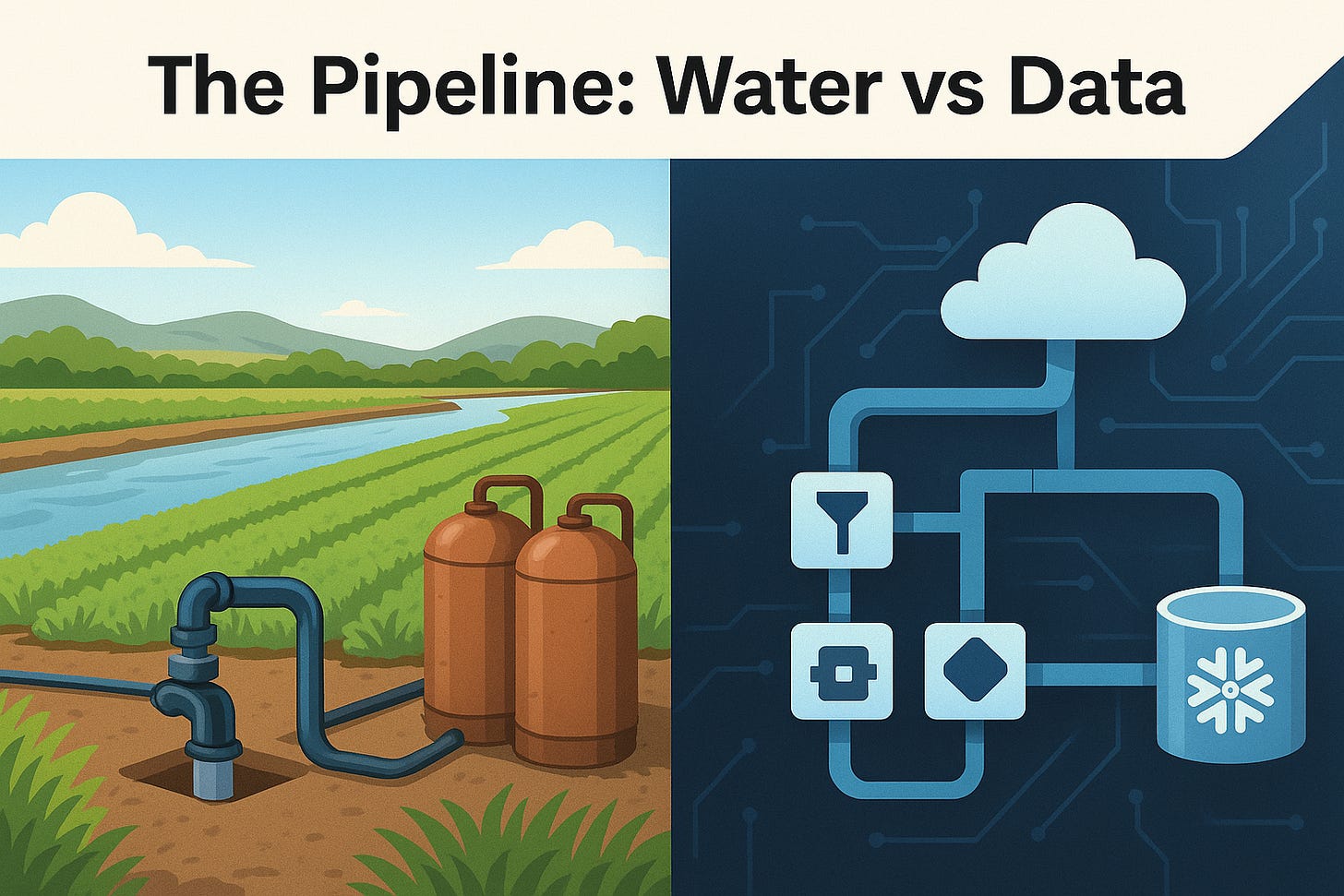The Pipeline: Water vs Data
What building irrigation systems on my father's farm taught me about designing modern data pipelines.
From Rivers to Reports – Lessons from My Father's Farm in Nzhelele
Growing up on a farm in Nzhelele, Limpopo, I learned early on that everything flows from the source. Whether it's water for crops or data for dashboards, managing flow efficiently is everything.
Today, I’m a software/data engineer. But before I built pipelines in the cloud, I helped my father build pipelines in the soil. On our farm, we rely on a blend of natural rivers, boreholes, gas tanks for fertigation, and carefully laid drip systems to ensure our crops thrive. That hands-on experience taught me something I now see clearly in my work every day: Water and data follow the same laws of flow, storage, and use.
1. The Source
Water:
On the farm, our sources are the Nzhelele River and underground boreholes. These feed our irrigation systems based on rainfall, seasonality, and crop needs.
Data:
In data engineering, our sources are APIs, databases, third-party platforms, or event streams. Just like rivers can flood or dry up, data sources can be unreliable or vary in volume.
Lesson: You need to understand your source—its reliability, purity, and volume—before designing your pipeline.
2. Mapping & Routing
Water:
We channel water from the river or borehole through pumps and pipes into storage tanks. From there, it flows into the drip irrigation system that feeds the crops, drop by drop.
Data:
We extract raw data from the source using tools like Airbyte, Fivetran, or custom scripts, then move it through ETL/ELT pipelines to a central repository.
Lesson: Whether you're routing water to crops or data to dashboards, mapping the journey from extraction to end use is critical.
3. Conditioning & Storage
Water:
Here’s a detail I love—on the farm, we use repurposed gas tanks as fertigation tanks, mixing nutrients into the water before it reaches the plants. It’s efficient, sustainable, and tailored to our soil.
Data:
We often enrich or transform data in transit maybe we join it with reference tables, clean it, or convert formats. Once prepped, it lands in a data warehouse like Snowflake, Redshift, or BigQuery.
Lesson: You don't always use water or data raw. Conditioning whether through filtration or transformation adds value and relevance.
4. Storage
Water:
We store water in overhead or underground tanks. This buffer gives us resilience in dry periods, and lets us control the flow rate for different crop zones.
Data:
Data is stored in structured formats in cloud data warehouses or lakes. It’s partitioned, secured, and optimized for query performance.
Lesson: Storage isn't just about capacity. It's about accessibility, organization, and readiness for use.
5. Query & Consumption
Water:
Through our drip irrigation system, we deliver water in measured amounts to specific plants—avocados, citrus, maize. The goal is targeted delivery—no more, no less.
Data:
Dashboards, reports, ML models—they all “consume” data through queries. Good architecture ensures they get only what they need, in the right format, fast.
Lesson: The end user plant or person should receive data or water tailored to their needs without waste.
The Bigger Picture: From Farming to Engineering
Watching water flow through pipes on the farm taught me the value of designing for scale, precision, and sustainability. As a data engineer, I build pipelines with the same values:
Monitor the flow (metrics, logs, gauges)
Detect leaks (data quality checks, alerts)
Automate delivery (scheduled jobs, Airflow DAGs)
Optimize usage (cost, latency, accuracy)
Just like farming, data engineering isn’t about flashy tools—it’s about understanding flow and building systems that nourish the user, whether that’s a pepper plant in Nzhelele or a machine learning model in the cloud.
Final Thought
When I explain my work to my father, I don’t use the words “ETL” or “cloud-native orchestration.” I just say:
“I do for data what you taught me to do for water.”
And he gets it.
Like this article?
Follow me for more stories at the intersection of farming, engineering, and systems thinking.
Repos & Roots – where technology meets tradition.






